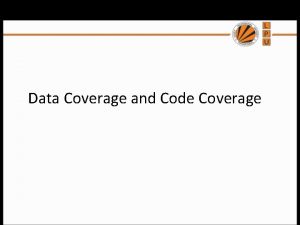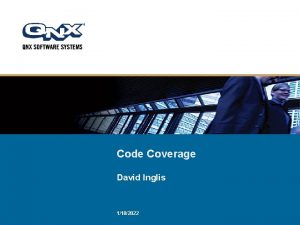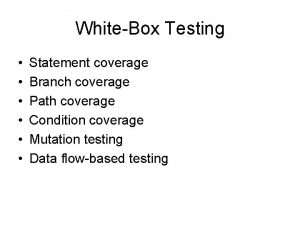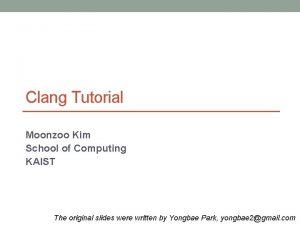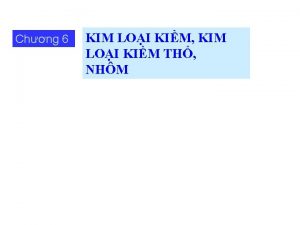Graph Coverage for Source Code Moonzoo Kim School








![Example Control Flow – Stats public static void compute. Stats (int [ ] numbers) Example Control Flow – Stats public static void compute. Stats (int [ ] numbers)](https://slidetodoc.com/presentation_image_h/176ff867d29ca0c0bc2a2a8871f13abb/image-9.jpg)
![Control Flow Graph for Stats public static void compute. Stats (int [ ] numbers) Control Flow Graph for Stats public static void compute. Stats (int [ ] numbers)](https://slidetodoc.com/presentation_image_h/176ff867d29ca0c0bc2a2a8871f13abb/image-10.jpg)




![Example Data Flow – Stats public static void compute. Stats (int [ ] numbers) Example Data Flow – Stats public static void compute. Stats (int [ ] numbers)](https://slidetodoc.com/presentation_image_h/176ff867d29ca0c0bc2a2a8871f13abb/image-15.jpg)








- Slides: 23

Graph Coverage for Source Code Moonzoo Kim School of Computing KAIST The original slides are taken from Chap. 7 of Intro. to SW Testing 2 nd ed by Ammann and Offutt

Overview n n n The most common application of graph criteria is to program source Graph : Usually the control flow graph (CFG) Node coverage : Execute every statement Edge coverage : Execute every branch Loops : Looping structures such as for loops, while loops, etc. Data flow coverage : Augment the CFG n n defs are statements that assign values to variables uses are statements that use variables

Control Flow Graphs n n n A CFG models all executions of a method by describing control structures Nodes : Statements or sequences of statements (basic blocks) Edges : Transfers of control Basic Block : A sequence of statements such that if the first statement is executed, all statements will be (no branches) CFGs are sometimes annotated with extra information n n branch predicates defs uses Rules for translating statements into graphs …

CFG : The if Statement if (x < y) { y = 0; x = x + 1; } else { x = y; } 1 x<y y=0 x=x+1 x >= y 2 3 x=y 4 if (x < y) { y = 0; x = x + 1; } 1 x<y y=0 x=x+1 x >= y 2 3

CFG : The if-Return Statement if (x < y) { return; } print (x); return; 1 x<y return x >= y 2 3 No edge from node 2 to 3. The return nodes must be distinct. print (x) return

Loops n Loops require “extra” nodes to be added n Nodes that do not represent statements or basic blocks

CFG : while and for Loops x = 0; while (x < y) { y = f (x, y); x = x + 1; } x=0 1 dummy node 2 x<y x >= y 3 4 implicitly initializes loop x=0 y =f(x, y) x=x+1 1 2 for (x = 0; x < y; x++) { y = f (x, y); } y = f (x, y) implicitly increments loop x<y x >= y 3 5 4 x=x+1

CFG : The case (switch) Structure read ( c) ; switch ( c ) { case ‘N’: y = 25; break; case ‘Y’: y = 50; break; default: y = 0; break; } print (y); read ( c ); 1 c == ‘N’ y = 25; break; 2 c == ‘Y’ default 3 4 y = 50; break; 5 print (y); y = 0; break;
![Example Control Flow Stats public static void compute Stats int numbers Example Control Flow – Stats public static void compute. Stats (int [ ] numbers)](https://slidetodoc.com/presentation_image_h/176ff867d29ca0c0bc2a2a8871f13abb/image-9.jpg)
Example Control Flow – Stats public static void compute. Stats (int [ ] numbers) { int length = numbers. length; double med, var, sd, mean, sum, varsum; sum = 0; for (int i = 0; i < length; i++) { sum += numbers [ i ]; } med = numbers [ length / 2 ]; mean = sum / (double) length; varsum = 0; for (int i = 0; i < length; i++) { varsum = varsum + ((numbers [ I ] - mean) * (numbers [ I ] - mean)); } var = varsum / ( length - 1. 0 ); sd = Math. sqrt ( var ); } System. out. println ("length: " + length); System. out. println ("mean: " + mean); System. out. println ("median: " + med); System. out. println ("variance: " + var); System. out. println ("standard deviation: " + sd);
![Control Flow Graph for Stats public static void compute Stats int numbers Control Flow Graph for Stats public static void compute. Stats (int [ ] numbers)](https://slidetodoc.com/presentation_image_h/176ff867d29ca0c0bc2a2a8871f13abb/image-10.jpg)
Control Flow Graph for Stats public static void compute. Stats (int [ ] numbers) { int length = numbers. length; double med, var, sd, mean, sum, varsum; sum = 0; for (int i = 0; i < length; i++) { sum += numbers [ i ]; } med = numbers [ length / 2 ]; mean = sum / (double) length; 1 2 3 i=0 i >= length varsum = 0; i < length for (int i = 0; i < length; i++) i++ 4 { varsum = varsum + ((numbers [ I ] - mean) * (numbers [ I ] - mean)); } var = varsum / ( length - 1. 0 ); sd = Math. sqrt ( var ); } System. out. println ("length: " + length); System. out. println ("mean: " + mean); System. out. println ("median: " + med); System. out. println ("variance: " + var); System. out. println ("standard deviation: " + sd); 5 i=0 6 i < length i >= length 7 8 i++

Control Flow TRs and Test Paths – EC 1 Edge Coverage 2 Test Path 9 TRs A. [ 1, 2 ] [ 1, 2, 3, 4, 3, 5, 6, 7, 6, 8 ] B. [ 2, 3 ] C. [ 3, 4 ] D. [ 3, 5 ] E. [ 4, 3 ] F. [ 5, 6 ] G. [ 6, 7 ] H. [ 6, 8 ] I. [ 7, 6 ] 3 4 5 6 7 8

Control Flow TRs and Test Paths – EPC 1 Edge-Pair Coverage 2 3 4 5 6 7 8 12 TRs A. [ 1, 2, 3 ] B. [ 2, 3, 4 ] C. [ 2, 3, 5 ] D. [ 3, 4, 3 ] E. [ 3, 5, 6 ] F. [ 4, 3, 5 ] G. [ 5, 6, 7 ] H. [ 5, 6, 8 ] I. [ 6, 7, 6 ] J. [ 7, 6, 8 ] K. [ 4, 3, 4 ] L. [ 7, 6, 7 ] Test Paths i. [ 1, 2, 3, 4, 3, 5, 6, 7, 6, 8 ] ii. [ 1, 2, 3, 5, 6, 8 ] iii. [ 1, 2, 3, 4, 3, 5, 6, 7, 6, 8 ] TP TRs toured i A, B, D, E, F, G, I, J ii A, C, E, H iii A, B, D, E, F, G, I, J, K, L sidetrips C, H Bug detected C, H

Control Flow TRs and Test Paths – PPC Prime Path Coverage 1 2 3 4 5 6 7 10 TRs Test Paths A. [ 3, 4, 3 ] i. [ 1, 2, 3, 4, 3, 5, 6, 7, 6, 8 ] B. [ 4, 3, 4 ] ii. [ 1, 2, 3, 4, 3, C. [ 7, 6, 7 ] 5, 6, 7, 6, 8 ] Infeasible D. [ 7, 6, 8 ] iii. [ 1, 2, 3, 4, 3, 5, 6, 8 ] Infeasible E. [ 6, 7, 6 ] iv. [ 1, 2, 3, 5, 6, 7, 6, 8 ] F. [ 1, 2, 3, 4 ] v. [ 1, 2, 3, 5, 6, 8 ] G. [4, 3, 5, 6, 7] Infeasible TP sidetrips TRs toured H. [4, 3, 5, 6, 8] Infeasible A, D, E, F, G i H, I, J I. [ 1, 2, 3, 5, 6, 7 ] ii A, B, C, D, E, F, G, H, I, J J. [ 1, 2, 3, 5, 6, 8 ] 8 iii A, F, H J iv D, E, F, I J v J Minimum # of test paths to cover all TRs? 4

Data Flow Coverage for Source n def : a location where a value is stored into memory n n n use : a location where variable’s value is accessed n n n x appears on the left side of an assignment (x = 44; ) x is an actual parameter in a call and the method changes its value x is a formal parameter of a method (implicit def when method starts) x is an input to a program x appears on the right side of an assignment x appears in a conditional test x is an actual parameter to a method x is an output of the program x is an output of a method in a return statement If a def and a use appear on the same node, then it is only a DU-pair if the def occurs after the use and the node is in a loop
![Example Data Flow Stats public static void compute Stats int numbers Example Data Flow – Stats public static void compute. Stats (int [ ] numbers)](https://slidetodoc.com/presentation_image_h/176ff867d29ca0c0bc2a2a8871f13abb/image-15.jpg)
Example Data Flow – Stats public static void compute. Stats (int [ ] numbers) { int length = numbers. length; double med, var, sd, mean, sum, varsum; sum = 0; for (int i = 0; i < length; i++) { sum += numbers [ i ]; } mean = sum / (double) length; med = numbers [ length / 2 ]; varsum = 0; for (int i = 0; i < length; i++) { varsum = varsum + ((numbers [ i ] - mean) * (numbers [ i ] - mean)); } var = varsum / ( length - 1. 0 ); sd = Math. sqrt ( var ); } System. out. println ("length: " + length); System. out. println ("mean: " + mean); System. out. println ("median: " + med); System. out. println ("variance: " + var); System. out. println ("standard deviation: " + sd);

Control Flow Graph for Stats 1 ( numbers ) sum = 0 length = numbers. length 2 i=0 3 i >= length i < length 4 5 sum += numbers [ i ] i++ mean = sum / (double) length; med = numbers [ length / 2 ] varsum = 0 i=0 6 i >= length i < length varsum = … i++ 7 8 var = varsum / ( length - 1. 0 ) sd = Math. sqrt ( var ) print (length, mean, med, var, sd)

CFG for Stats – With Defs & Uses 1 def (1) = { numbers, sum, length } 2 def (2) = { i } 3 use (3, 5) = { i, length } use (3, 4) = { i, length } 4 5 def (5) = { mean, med, varsum, i } use (5) = { numbers, length, sum } def (4) = { sum, i } use (4) = { sum, numbers, i } 6 use (6, 8) = { i, length } use (6, 7) = { i, length } 7 def (7) = { varsum, i } use (7) = { varsum, numbers, i, mean } 8 def (8) = { var, sd } use (8) = { varsum, length, mean, med, var, sd }

Defs and Uses Tables for Stats Node 1 Def Use 2 { numbers, sum, length } {i} 3 4 { sum, i } { numbers, i, sum } { mean, med, varsum, i } { numbers, length, sum } 5 { varsum, i } 8 { var, sd } Use (1, 2) (2, 3) (3, 4) { i, length } (4, 3) (3, 5) { i, length } (5, 6) 6 7 Edge { varsum, numbers, i, mean } { varsum, length, var, mean, med, var, sd } (6, 7) { i, length } (7, 6) (6, 8) { i, length } 18

DU Pairs for Stats variable numbers length med var sd mean sum varsum i defs come before uses in DU Pairs As the same basic block (local use), data flow analysis does (1, 4) (1, 5) (1, 7) not use the DU pair (1, 5) (1, 8) (1, (3, 4)) (1, (3, 5)) (1, (6, 7)) (1, (6, 8)) (5, 8) (8, 8) defs after use in loop, these are valid DU pairs (8, 8) (5, 7) (5, 8) No def-clear path … (1, 4) (1, 5) (4, 4) (4, 5) different scope for i (5, 7) (5, 8) (7, 7) (7, 8) (2, 4) (2, (3, 4)) (2, (3, 5)) (2, 7) (2, (6, 7)) (2, (6, 8)) (4, 4) (4, (3, 4)) (4, (3, 5)) (4, 7) (4, (6, 7)) (4, (6, 8)) (5, 7) (5, (6, 7)) (5, (6, 8)) No path through graph from (7, 7) (7, (6, 7)) (7, (6, 8)) nodes 5 and 7 to 4 or 3 19

DU Paths for Stats variable numbers length med var sd sum DU Pairs DU Paths (1, 4) (1, 5) (1, 7) [ 1, 2, 3, 4 ] [ 1, 2, 3, 5, 6, 7 ] (1, 5) (1, 8) (1, (3, 4)) (1, (3, 5)) (1, (6, 7)) (1, (6, 8)) [ 1, 2, 3, 5 ] [ 1, 2, 3, 5, 6, 8 ] [ 1, 2, 3, 4 ] [ 1, 2, 3, 5, 6, 7 ] [ 1, 2, 3, 5, 6, 8 ] (5, 8) (8, 8) (1, 4) (1, 5) (4, 4) (4, 5) [ 5, 6, 8 ] No path needed [ 1, 2, 3, 4 ] [ 1, 2, 3, 5 ] [ 4, 3, 4 ] [ 4, 3, 5 ] variable mean DU Pairs (5, 7) (5, 8) DU Paths [ 5, 6, 7 ] [ 5, 6, 8 ] varsum (5, 7) (5, 8) (7, 7) (7, 8) [ 5, 6, 7 ] [ 5, 6, 8 ] [ 7, 6, 7 ] [ 7, 6, 8 ] i (2, 4) (2, (3, 4)) (2, (3, 5)) (4, 4) (4, (3, 4)) (4, (3, 5)) (5, 7) (5, (6, 7)) (5, (6, 8)) (7, 7) (7, (6, 7)) (7, (6, 8)) [ 2, 3, 4 ] [ 2, 3, 5 ] [ 4, 3, 4 ] [ 4, 3, 5 ] [ 5, 6, 7 ] [ 5, 6, 8 ] [ 7, 6, 7 ] [ 7, 6, 8 ] 20

DU Paths for Stats – No Duplicates There are 38 DU paths for Stats, but only 12 unique [ 1, 2, 3, 4 ] [ 1, 2, 3, 5, 6, 7 ] [ 1, 2, 3, 5, 6, 8 ] [ 2, 3, 4 ] [ 2, 3, 5 ] [ 4, 3, 4 ] [ 4, 3, 5 ] [ 5, 6, 7 ] [ 5, 6, 8 ] [ 7, 6, 7 ] [ 7, 6, 8 ] 4 expect a loop not to be “entered” 6 require at least one iteration of a loop 2 require at least two iteration of a loop

Test Cases and Test Paths w. r. t. Loop behavior Test Case : numbers = (2, 10, 15) ; length = 3 Test Path : [ 1, 2, 3, 4, 3, 5, 6, 7, 6, 8 ] 100% node and edge DU Paths covered (no sidetrips) coverage achieved [ 4, 3, 4 ] [ 7, 6, 7 ] The two stars that require at least two iterations of a loop Test Case : numbers = (44) ; length = 1 Test Path : [ 1, 2, 3, 4, 3, 5, 6, 7, 6, 8 ] Additional DU Paths covered (no sidetrips) [ 1, 2, 3, 4 ] [ 4, 3, 5 ] [ 5, 6, 7 ] [ 7, 6, 8 ] The five stars that require at least one iteration of a loop A bug found Other DU paths require arrays with length 0 to skip loops But the method fails with divide by zero on the statement … mean = sum / (double) length;

Summary n Applying the graph test criteria to control flow graphs is relatively straightforward n Most of the developmental research work was done with CFGs n A few subtle decisions must be made to translate control structures into the graph n Some tools will assign each statement to a unique node n n These slides and the book uses basic blocks Coverage is the same, although the bookkeeping will differ
 Difference between source code and machine code
Difference between source code and machine code Coverage testing
Coverage testing Busceral
Busceral Cyclomatic complexity example
Cyclomatic complexity example Emma code coverage
Emma code coverage Fspos vägledning för kontinuitetshantering
Fspos vägledning för kontinuitetshantering Typiska drag för en novell
Typiska drag för en novell Nationell inriktning för artificiell intelligens
Nationell inriktning för artificiell intelligens Vad står k.r.å.k.a.n för
Vad står k.r.å.k.a.n för Shingelfrisyren
Shingelfrisyren En lathund för arbete med kontinuitetshantering
En lathund för arbete med kontinuitetshantering Underlag för särskild löneskatt på pensionskostnader
Underlag för särskild löneskatt på pensionskostnader Tidbok
Tidbok A gastrica
A gastrica Förklara densitet för barn
Förklara densitet för barn Datorkunskap för nybörjare
Datorkunskap för nybörjare Tack för att ni lyssnade bild
Tack för att ni lyssnade bild Mall debattartikel
Mall debattartikel Delegerande ledarskap
Delegerande ledarskap Nyckelkompetenser för livslångt lärande
Nyckelkompetenser för livslångt lärande Påbyggnader för flakfordon
Påbyggnader för flakfordon Vätsketryck formel
Vätsketryck formel Offentlig förvaltning
Offentlig förvaltning Kyssande vind analys
Kyssande vind analys



